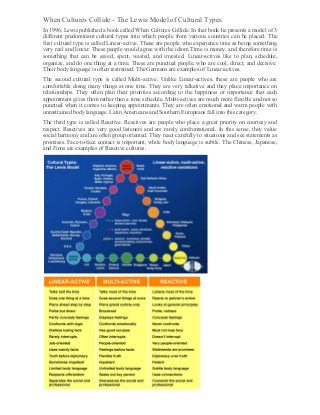
When cultures collide
- 1. When Cultures Collide - The Lewis Model of Cultural Types In 1996, Lewis published a book called When Cultures Collide. In that book he presents a model of 3 different predominant cultural types into which people from various countries can be placed. The first cultural type is called Linear-active. These are people who experience time as being something very real and linear. These people would agree with the idiom Time is money, and therefore time is something that can be saved, spent, wasted, and invested. Linear-actives like to plan, schedule, organize, and do one thing at a time. These are punctual people, who are cool, direct, and decisive. Their body language is often restrained. The Germans are examples of Linear-actives. The second cultural type is called Multi-active. Unlike Linear-actives, these are people who are comfortable doing many things at one time. They are very talkative and they place importance on relationships. They often plan their priorities according to the happiness or importance that each appointment gives them rather than a time schedule. Multi-actives are much more flexible and not so punctual when it comes to keeping appointments. They are often emotional and warm people with unrestrained body language. Latin Americans and Southern Europeans fall into this category. The third type is called Reactive. Reactives are people who place a great priority on courtesy and respect. Reactives are very good listeners and are rarely confrontational. In this sense, they value social harmony and are often group oriented. They react carefully to situations and see statements as promises. Face-to-face contact is important, while body language is subtle. The Chinese, Japanese, and Finns are examples of Reactive cultures.